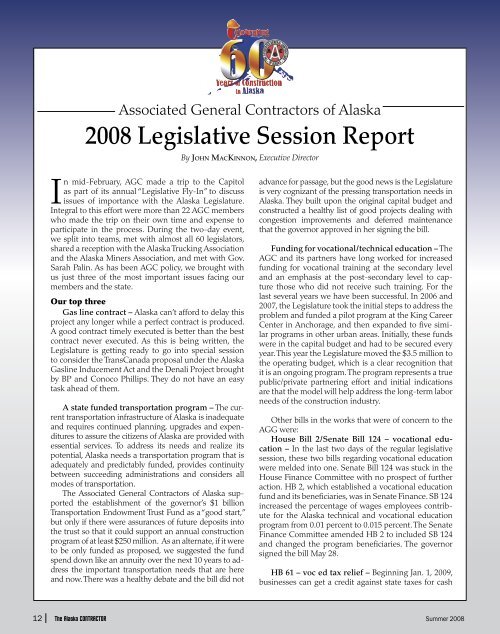The Alaska Contractor - Summer 2008
The Alaska Contractor - Summer 2008
The Alaska Contractor - Summer 2008
You also want an ePaper? Increase the reach of your titles
YUMPU automatically turns print PDFs into web optimized ePapers that Google loves.
Associated General <strong>Contractor</strong>s of <strong>Alaska</strong><br />
<strong>2008</strong> Legislative Session Report<br />
In mid-February, AGC made a trip to the Capitol<br />
as part of its annual “Legislative Fly-In” to discuss<br />
issues of importance with the <strong>Alaska</strong> Legislature.<br />
By JOHN MACKINNON, Executive Director<br />
<br />
Integral to this effort were more than 22 AGC members<br />
who made the trip on their own time and expense to<br />
participate in the process. During the two-day event,<br />
<br />
we split into teams, met with almost all 60 legislators,<br />
shared a reception with the <strong>Alaska</strong> Trucking Association<br />
and the <strong>Alaska</strong> Miners Association, and met with Gov.<br />
Sarah Palin. As has been AGC policy, we brought with<br />
us just three of the most important issues facing our<br />
members and the state.<br />
Our top three<br />
Gas line contract – <strong>Alaska</strong> can’t afford to delay this<br />
project any longer while a perfect contract is produced.<br />
A good contract timely executed is better than the best<br />
<br />
contract never executed. As this is being written, the<br />
Legislature is getting ready to go into special session<br />
to consider the TransCanada proposal under the <strong>Alaska</strong><br />
Gasline Inducement Act and the Denali Project brought<br />
by BP and Conoco Phillips. <strong>The</strong>y do not have an easy<br />
task ahead of them.<br />
A state funded transportation program – <strong>The</strong> current<br />
transportation infrastructure of <strong>Alaska</strong> is inadequate<br />
and requires continued planning, upgrades and expenditures<br />
to assure the citizens of <strong>Alaska</strong> are provided with<br />
essential services. To address its needs and realize its<br />
potential, <strong>Alaska</strong> needs a transportation program that is<br />
adequately and predictably funded, provides continuity<br />
between succeeding administrations and considers all<br />
modes of transportation.<br />
<strong>The</strong> Associated General <strong>Contractor</strong>s of <strong>Alaska</strong> supported<br />
the establishment of the governor’s $1 billion<br />
Transportation Endowment Trust Fund as a “good start,”<br />
but only if there were assurances of future deposits into<br />
the trust so that it could support an annual construction<br />
program of at least $250 million. As an alternate, if it were<br />
to be only funded as proposed, we suggested the fund<br />
spend down like an annuity over the next 10 years to address<br />
the important transportation needs that are here<br />
and now. <strong>The</strong>re was a healthy debate and the bill did not<br />
advance for passage, but the good news is the Legislature<br />
is very cognizant of the pressing transportation needs in<br />
<strong>Alaska</strong>. <strong>The</strong>y built upon the original capital budget and<br />
constructed a healthy list of good projects dealing with<br />
congestion improvements and deferred maintenance<br />
that the governor approved in her signing the bill.<br />
Funding for vocational/technical education – <strong>The</strong><br />
AGC and its partners have long worked for increased<br />
funding for vocational training at the secondary level<br />
and an emphasis at the post-secondary level to capture<br />
those who did not receive such training. For the<br />
last several years we have been successful. In 2006 and<br />
2007, the Legislature took the initial steps to address the<br />
problem and funded a pilot program at the King Career<br />
Center in Anchorage, and then expanded to five similar<br />
programs in other urban areas. Initially, these funds<br />
were in the capital budget and had to be secured every<br />
year. This year the Legislature moved the $3.5 million to<br />
the operating budget, which is a clear recognition that<br />
it is an ongoing program. <strong>The</strong> program represents a true<br />
public/private partnering effort and initial indications<br />
are that the model will help address the long-term labor<br />
needs of the construction industry.<br />
Other bills in the works that were of concern to the<br />
AGG were:<br />
House Bill 2/Senate Bill 124 – vocational education<br />
– In the last two days of the regular legislative<br />
session, these two bills regarding vocational education<br />
were melded into one. Senate Bill 124 was stuck in the<br />
House Finance Committee with no prospect of further<br />
action. HB 2, which established a vocational education<br />
fund and its beneficiaries, was in Senate Finance. SB 124<br />
increased the percentage of wages employees contribute<br />
for the <strong>Alaska</strong> technical and vocational education<br />
program from 0.01 percent to 0.015 percent. <strong>The</strong> Senate<br />
Finance Committee amended HB 2 to included SB 124<br />
and changed the program beneficiaries. <strong>The</strong> governor<br />
signed the bill May 28.<br />
HB 61 – voc ed tax relief – Beginning Jan. 1, 2009,<br />
businesses can get a credit against state taxes for cash
















